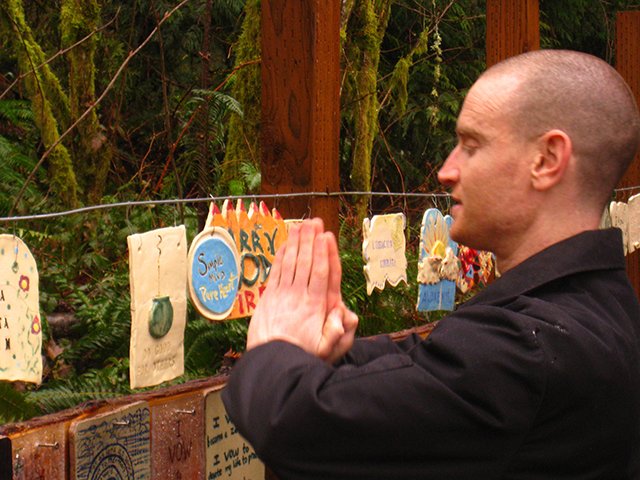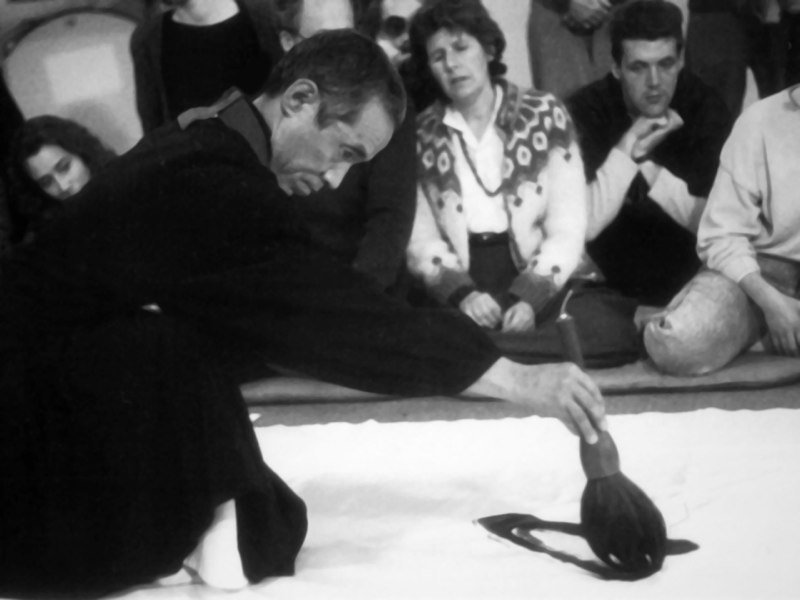“If you push against the movement, the direction of how things are existing, you have pain. If you flow with the movement, you feel freedom. You don’t get out of it, rather, you flow with it and have a sensation of freedom.”
by Joseph Hall
New Years Eve is a major holiday in the world of Zen. Each year, we gather in the temples on New Years Eve and write out a list of those aspects of our character that seem to be holding us back. Then we meditate for a couple of hours and ring the same bell 108 times trying to meet each one with a full bow. At midnight we burn the scraps of paper with our regrets and the celebration begins as we hobble to the kitchen to eat a bowl of noodles. For people who habitually arise early, conversations at this hour can feel a little uncertain and so the party usually lasts about an hour until we all head to our rooms or our cars.
Admittedly, of the many celebrations that will occur this weekend across the world, ours is a little somber. Then again, the day after is usually a day off and it is the waking up in the new year that Zen New Years Eve is really about. Basically, rather than exploring better living through chemistry, the activities at the temple are more about a cleanse. We reflect on what we would like to let go of, make the sound of a committed endeavor and then nourish ourselves for the profound opportunity ahead.
New Years Day brings two things, the long lonely stretch of winter over the coming months and the simple fact that the world is more attuned to our personal growth than at any other time during the year. Gyms, furniture stores, and travel websites discount their prices, often placing the tools we need for change within reach. Our friends suddenly care a little more about our personal growth and even if we don’t tell them how we are working from within, they still tend to inquire if we might have a resolution. If it sounds like a serious challenge, a number of them will even offer their support. We live in a world of seasons, and there is something about the winter that brings personal transformation into the realm of of possibility. It seems to me that this time of year always ends with some inner change so that growth I make this winter might as well reflect the direction I am trying to go. This seems like a better way to spend a winter rather than reflecting on how true the stories in the media about seasonally affected depression might actually be.
Resolutions are personal things, meant to meet a given life in a given moment. While what is worth resolving for you is unknowable to others, it’s always worthwhile to do a little maintenance work on the Dharma vehicle (that’s you) along the journey. The way an idea gets to become a resolution is that is usually hard to do and in some way the change is going to be unpleasant. Consequently, to make a resolution is to create a little turbulence in our our lives. If we quit a substance, there will be withdrawals. If we resolve to change the tone of our speech, we will accordingly find ourselves in moments where we are painfully at a loss with getting what we want. In the midst of chaotic emotions, it is easy to forget that the irritation that arises is truly in accord with the path we are on and is an intrinsic part of our growth. Our task is to not act from the discord and to keep our eyes open for new ways of moving through the world. These tend to appear when we simply stop doing what isn’t working and wait. So we spend a lot of time in our minds. If we stick with it long enough, the new ways become normal and we quickly forget how it was that we ever struggled. But first, things are going to get a little wonky.
Here is how one might align the tires in order to reduce all the noise coming from the road. Ritual can help create a sense of flow which goes a long way towards reducing the hum of change. I’m not talking about monastic forms but specifically about reflecting on the forms we have already unconsciously created in our lives and smoothing off the corners. We have a daily routine. Looking at the way we move through that goes a long way towards making something else possible. If, for instance, you accept the call to refrain from negative social media posts or email, thinking about what we don’t want all the time becomes disheartening somewhere during the second hour of our vow. What we really have to learn is to see what we read in a different way. The change doesn’t come from our refraining, but from building the as yet unrealized habits that nourish a different response. For most of the next month or so, the temptation will mainly be to try to fight impatience. Instead of fighting, it’s a lot easier to cultivate a little flow in a place where we can access it.
Whatever your resolution, it is a worthwhile endeavor to examine your daily routine and most importantly what it feels like to move through it. In these moments where we perform our mundane tasks, we can practice bringing our attention to our actions and discovering the simplest arc of motion that will refine the task at hand and gradually lead to a dance as we move through what was once a source of boredom and dissatisfaction. That after all, was how we got to the point where we needed to change.
Nobody will care about this of course and that’s what makes it irreplaceable. To begin, we pay attention as we pick up the laundry basket. If we are honest with ourselves, we notice that this activity became a habit long ago. We can see that we seem to take little joy in it and that the small mind has seized the head time to ruminate over things that have very little to do with sparkling colors or a neat stack of clothes. This is a good opportunity to notice rumination arise, and how the clothes in the drawers often seem to be in some stage of disarray. We are capable people and there are aspects to the results that just don’t reflect our intentions. Just notice this, no need to judge, remember you are growing and the laundry was a koan all along. The good news is that this is a koan you can resolve.
How do we work with such a Koan? Kobun has a few words that might illuminate this dilemma. “If you push against the movement, the direction of how things are existing, you have pain. If you flow with the movement, you feel freedom. You don’t get out of it, rather, you flow with it and have a sensation of freedom.” While existence is a big topic, this is a simple application so it’s worth looking at what is happening and how it changes things.
Sorting the clothes and adding the liquid, you might notice that going mostly on habit all this time has left a few sharp edges in your technique. Perhaps half of the clothes fall on the floor between the washer and dryer or maybe the sound of footsteps as you walk from room to room is louder that you had imagined. Anything can be refined and this transformation can be made sublime. Those moments lost to chores can be changed into a source of quiet joy. So why not sublimate the laundry? To do so, it will help to create a ritual, which while you may not want to describe it this way to your therapist, is the basic practice of a monk. If you’re still on the page, then it’s a good time to take a fresh look at the laundry. Rather than shoving in the clothes, curiosity will reveal all the secrets required to move through the task in one long curving arc. As you see the possibilities, feel free to weave the many details into the fabric of a personal ritual and a place of practice. Set an ideal, and with no-one watching you are free to learn a new way of being in these moments. Give the task your full attention and imagine the delightful form of washing clothes and offering them to others - which includes your future self.
Then, relax and try out the motions you saw. Feel the way your hands dance in rapt attention - which is, after all, the very source of rapture. Give this all the attention you can muster and move, curiously, and know that you have an inner sense of grace that will guide you to a state of flow. It’s a little clunky at first but quickly and then steadily you will soften the edges of your movements. In turn the mind will follow. Mindfulness is not a state we access directly, but what arises naturally when we pay attention, focus it on this moment, and stay curious. So as you’re doing laundry, as you practice, a sense of flow arises. It is right here, in the midst of everyday activity, that you have your greatest chance of awakening.
Returning from the laundry, we eventually realize that we still have some difficult thoughts and remain challenged by that resolution of ours. If a little dissatisfaction arises, it helps to also notice that we found respite in our little ritual and a sense of flow is growing. One might conclude that our more challenging NYE resolution is part of similar, but more restive undertaking. And thus, we are growing and all we have to do is stay between the lines and wait. Then again, it might be an excellent time to reexamine the dishes.






